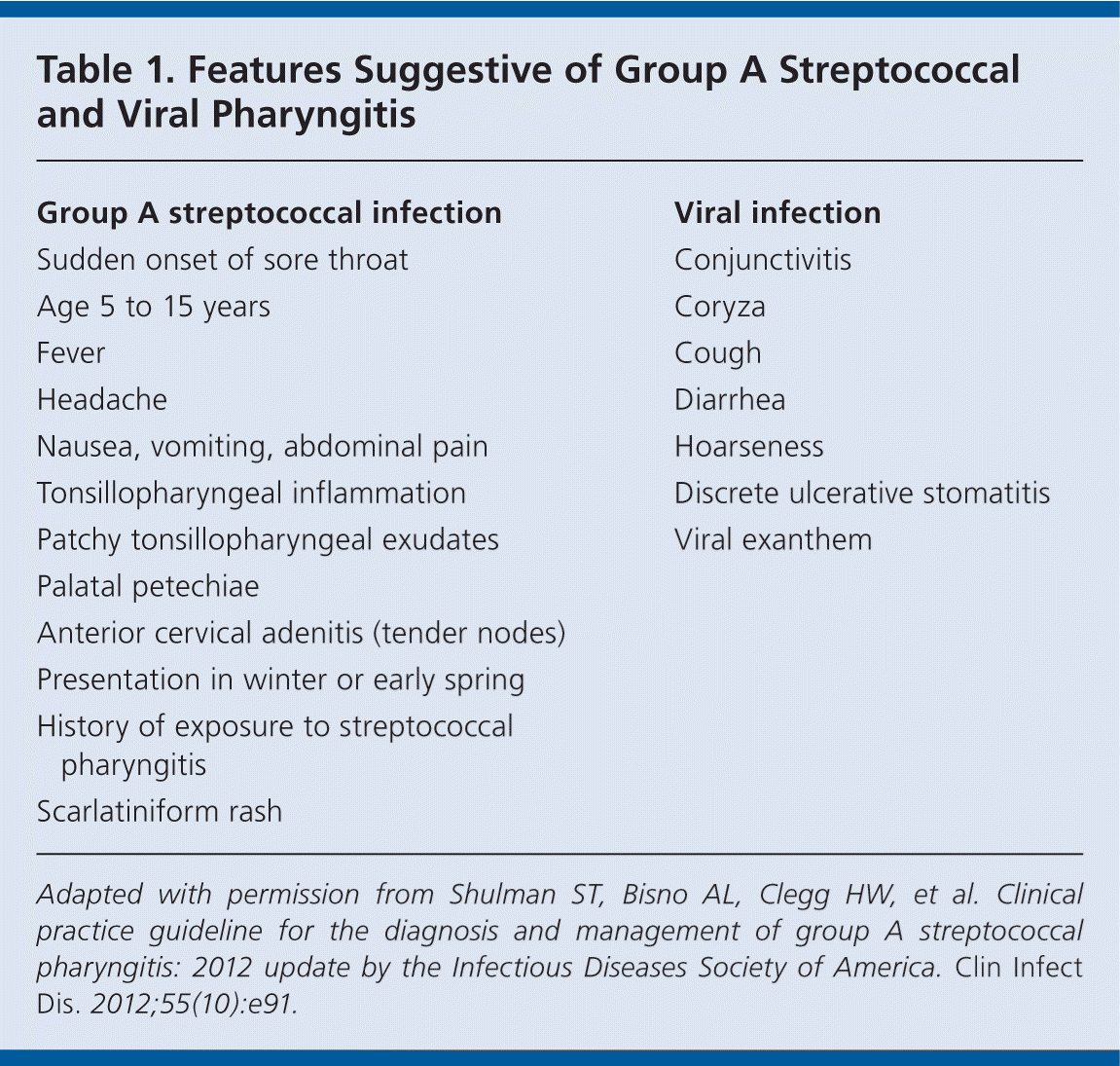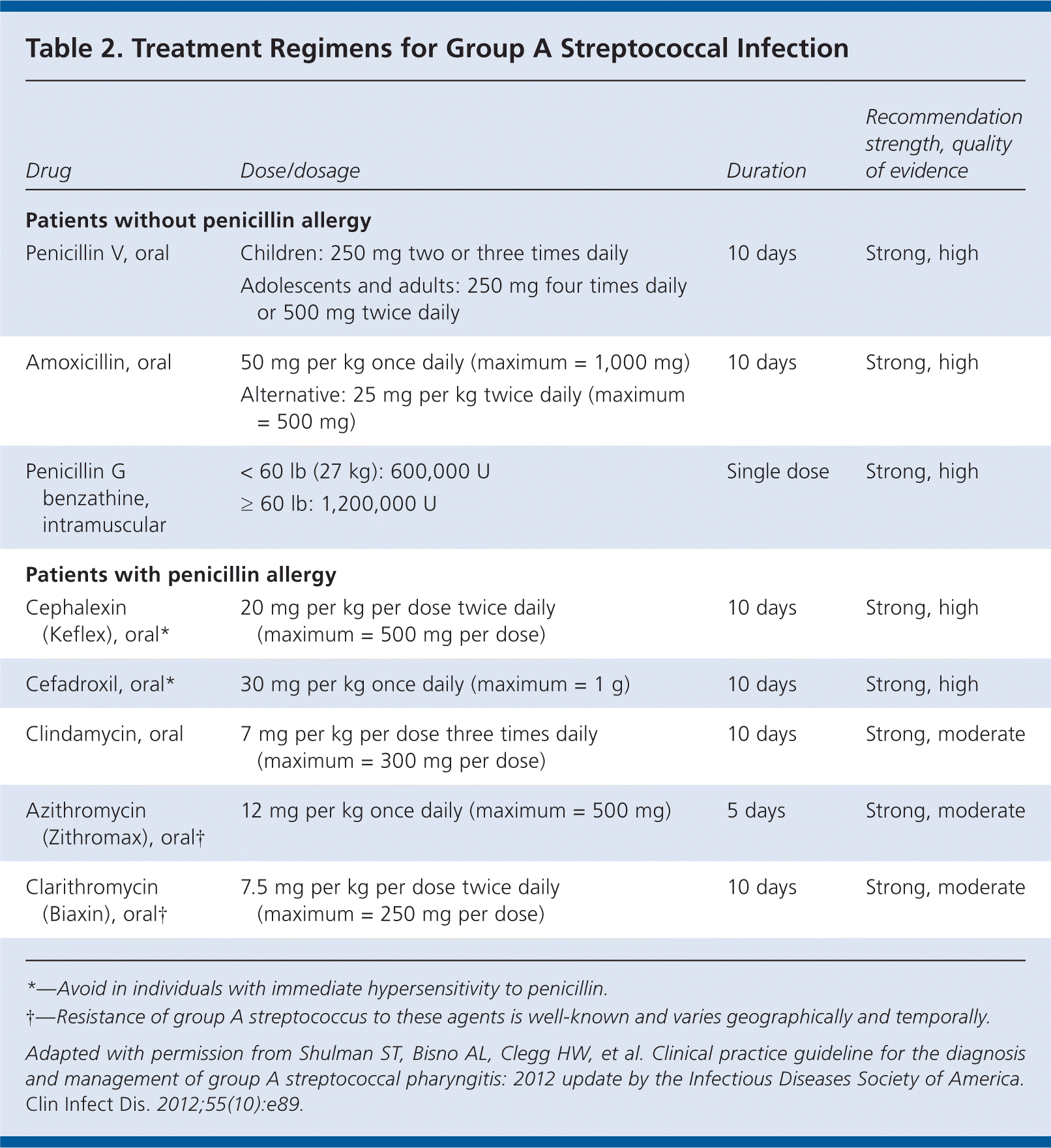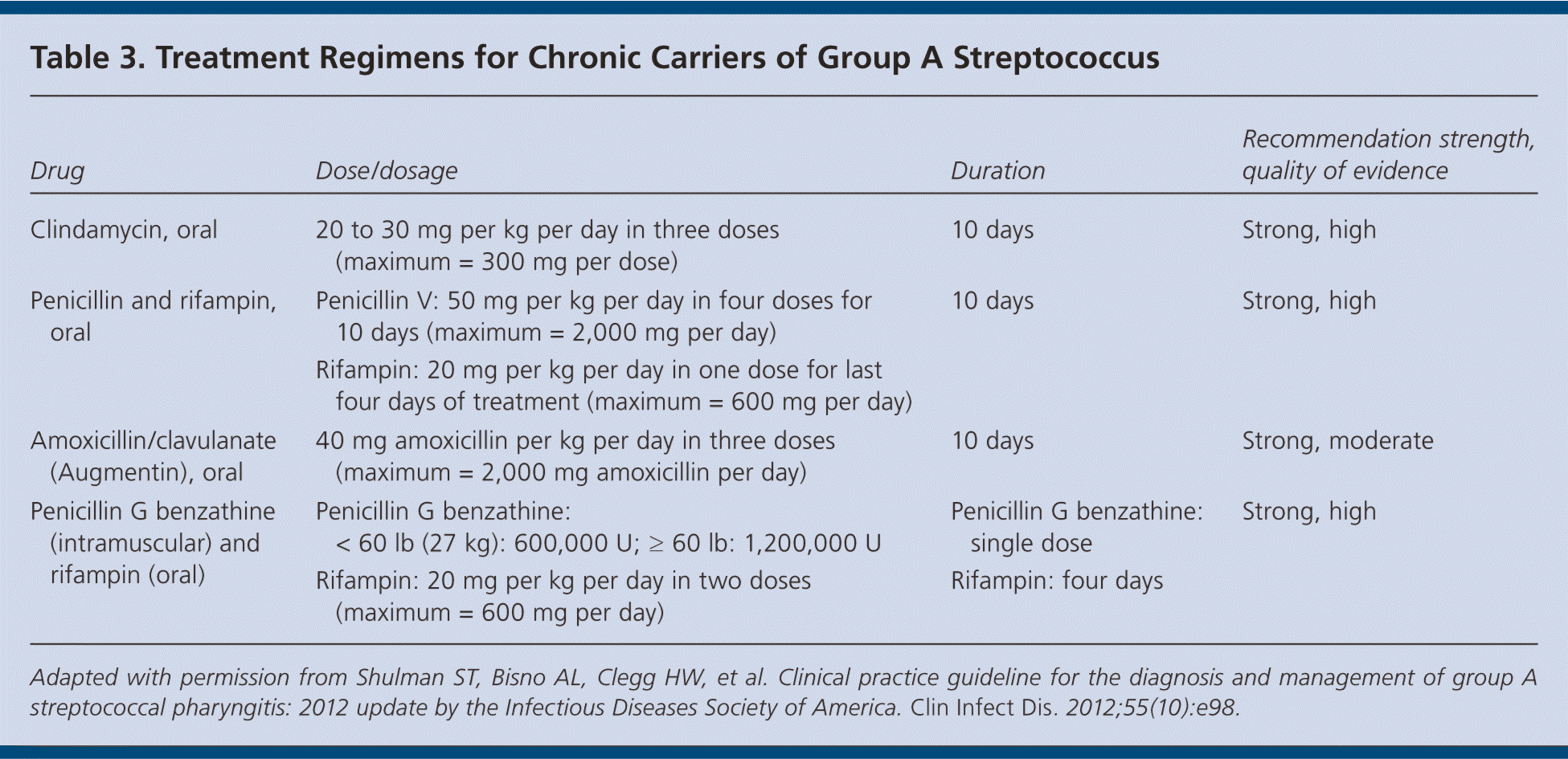
Am Fam Physician. 2013;88(5):338-340
Guideline source: Infectious Diseases Society of America
Evidence rating system used? Yes
Literature search described? Yes
Guideline developed by participants without relevant financial ties to industry? No
Published source: Clinical Infectious Diseases, September 2012
The Infectious Diseases Society of America (IDSA) has updated its 2002 guideline on managing group A streptococcal pharyngitis. The illness primarily occurs in children five to 15 years of age. Patients typically present with sudden onset of a sore throat, pain with swallowing, and fever. Examination shows tonsillopharyngeal erythema, often with lymphadenitis. The symptoms of streptococcal pharyngitis often overlap with those of viral pharyngitis, and the two cannot be differentiated using clinical features alone unless overt viral features are present.
Diagnosis
Clinical features of group A streptococcal pharyngitis and viral pharyngitis are listed in Table 1. Diagnosis of group A streptococcal pharyngitis should be confirmed using a rapid antigen detection test and/or culture of a throat swab.

| Group A streptococcal infection |
| Sudden onset of sore throat |
| Age 5 to 15 years |
| Fever |
| Headache |
| Nausea, vomiting, abdominal pain |
| Tonsillopharyngeal inflammation |
| Patchy tonsillopharyngeal exudates |
| Palatal petechiae |
| Anterior cervical adenitis (tender nodes) |
| Presentation in winter or early spring |
| History of exposure to streptococcal pharyngitis |
| Scarlatiniform rash |
| Viral infection |
| Conjunctivitis |
| Coryza |
| Cough |
| Diarrhea |
| Hoarseness |
| Discrete ulcerative stomatitis |
| Viral exanthem |
A positive result on rapid antigen detection testing is diagnostic for group A streptococcal pharyngitis. A backup culture should be performed in children and adolescents with negative test results. A backup culture generally is not necessary in adults because the incidence of the illness and the risk of subsequent rheumatic fever are low in adults; however, it can be considered. Antistreptococcal antibody titers are not recommended in the routine diagnosis of acute pharyngitis.
Diagnostic testing is not recommended if clinical features strongly suggest a viral etiology (e.g., cough, rhinorrhea, hoarseness, oral ulcers). Testing is generally not recommended in children younger than three years unless the child has risk factors, such as an older sibling with the illness, because the illness is uncommon in this age group. Follow-up posttreatment testing is not routinely recommended, but may be considered. Testing of household contacts of patients with group A streptococcal pharyngitis is not routinely recommended.
Treatment
Patients with acute group A streptococcal pharyngitis should be treated with an antibiotic that is likely to eradicate the organism, usually for 10 days. Penicillin or amoxicillin is commonly recommended because of its narrow spectrum of activity, few adverse effects, and modest cost. Alternative antibiotics for those with penicillin allergy include a first-generation cephalosporin, clindamycin, clarithromycin (Biaxin), or azithromycin (Zithromax). Table 2 summarizes antibiotic regimens for patients with and without penicillin allergy.

| Drug | Dose/dosage | Duration | Recommendation strength, quality of evidence |
|---|---|---|---|
| Patients without penicillin allergy | |||
| Penicillin V, oral | Children: 250 mg two or three times daily | 10 days | Strong, high |
| Adolescents and adults: 250 mg four times daily or 500 mg twice daily | |||
| Amoxicillin, oral | 50 mg per kg once daily (maximum = 1,000 mg) | 10 days | Strong, high |
| Alternative: 25 mg per kg twice daily (maximum= 500 mg) | |||
| Penicillin G benzathine, intramuscular | < 60 lb (27 kg): 600,000 U | Single dose | Strong, high |
| ≥ 60 lb: 1,200,000 U | |||
| Patients with pencillin allergy | |||
| Cephalexin (Keflex), oral* | 20 mg per kg per dose twice daily (maximum = 500 mg per dose) | 10 days | Strong, high |
| Cefadroxil, oral* | 30 mg per kg once daily (maximum = 1 g) | 10 days | Strong, high |
| Clindamycin, oral | 7 mg per kg per dose three times daily (maximum = 300 mg per dose) | 10 days | Strong, moderate |
| Azithromycin (Zithromax), oral† | 12 mg per kg once daily (maximum = 500 mg) | 5 days | Strong, moderate |
| Clarithromycin (Biaxin), oral† | 7.5 mg per kg per dose twice daily (maximum = 250 mg per dose) | 10 days | Strong, moderate |
Adjunctive therapy with an analgesic or antipyretic (e.g., acetaminophen, nonsteroidal anti-inflammatory drugs) can be considered to treat moderate to severe symptoms or control a high fever. Aspirin should not be used in children, and adjunctive corticosteroids are not recommended in the treatment of group A streptococcal pharyngitis.
Patients with recurrent pharyngitis and laboratory evidence of group A streptococcus may be chronic carriers who are having repeated viral infections. Antibiotics are not generally recommended in this case, but may be considered in the following situations: (1) during a community outbreak of acute rheumatic fever, acute poststreptococcal glomerulonephritis, or invasive group A streptococcal infection; (2) during an outbreak of group A streptococcal pharyngitis in a closed or partially closed community; (3) when the patient has a family or personal history of acute rheumatic fever; (4) when the patient or family has excessive anxiety about group A streptococcal infections; or (5) when tonsillectomy is being considered only because the patient is a chronic carrier.
Other antibiotic regimens have been shown to be substantially more effective than penicillin or amoxicillin alone in eliminating chronic streptococcal carriage. Table 3 summarizes the treatment options.

| Drug | Dose/dosage | Duration | Recommendation strength,quality of evidence | |
|---|---|---|---|---|
| Clindamycin, oral | 20 to 30 mg per kg per day in three doses (maximum = 300 mg per dose) | 10 days | Strong, high | |
| Penicillin and rifampin, oral | Penicillin V: 50 mg per kg per day in four doses for 10 days (maximum = 2,000 mg per day) | 10 days | Strong, high | |
| Rifampin: 20 mg per kg per day in one dose for last four days of treatment (maximum = 600 mg per day) | ||||
| Amoxicillin/clavulanate (Augmentin), oral | 40 mg amoxicillin per kg per day in three doses (maximum = 2,000 mg amoxicillin per day) | 10 days | Strong, moderate | |
| Penicillin G benzathine (intramuscular) and rifampin (oral) | Penicillin G benzathine: < 60 lb (27 kg): 600,000 U; ≥ 60 lb: 1,200,000 U | Penicillin G benzathine: single dose | Strong, high | |
| Rifampin: 20 mg per kg per day in two doses (maximum = 600 mg per day) | Rifampin: four days | |||
